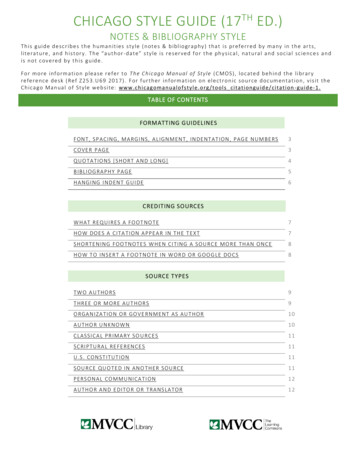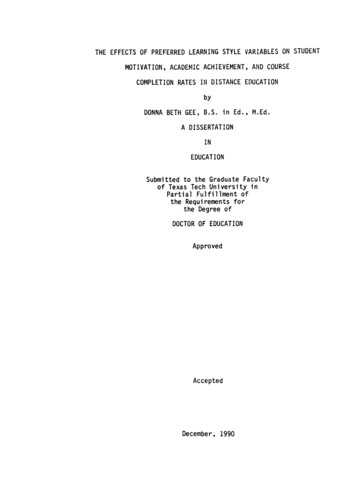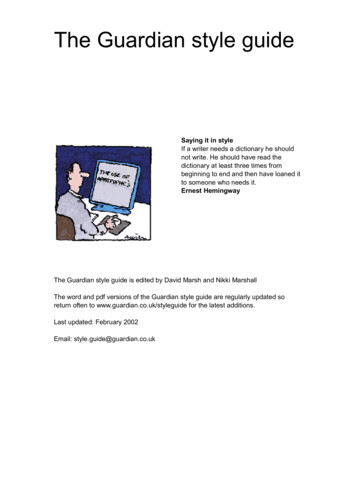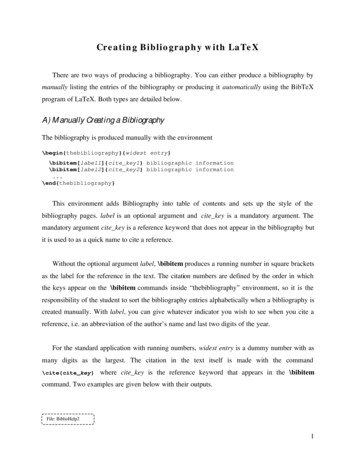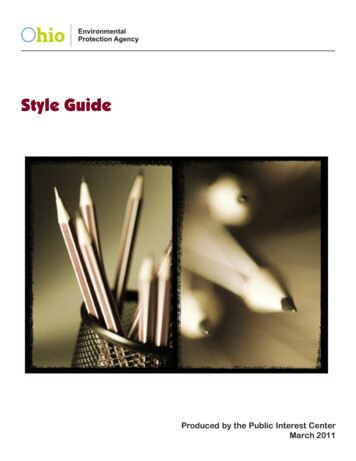
Transcription
The Elements of AIML StyleMarch 28, 2003ByDr. Richard S. W A L L A C E 2003 ALICE A. I. Foundation, Inc.1
The Elements of AIML Style is a no-nonsense technical book that takes you on a journey from the first stepsof creating your own bot with AIML, through all the questions and answers every botmaster asks, toadvanced A.I. and hard-nosed business applications of AIML. The trip ends with a brief glimpse into thefuture of bots and AIML.2
INTRODUCTION . 5WHAT MAKES ALICE WORK?. 6A REVOLUTION IN A.I. 10CHAPTER I. Overview of AIML. 12CATEGORIES . 12RECURSION. 13SYMBOLIC REDUCTIONS. 13DIVIDE AND CONQUER . 14SYNONYMS . 14SPELLING AND GRAMMER CORRECTION. 15KEYWORDS . 15CONDITIONALS . 16TARGETING. 16CONTEXT. 17CHAPTER II. AIML Pattern Matching. 21THE GRAPHMASTER . 21THE ALICE BRAIN PICTURE GALLERY . 23CHAPTER III. Symbolic Reductions in AIML. 33MULTIPLE WILDCARDS . 35CHAPTER IV. Botmaster Questions and Answers . 36- What is the goal for AIML? . 36- Who is the botmaster? . 37- How can I create my own chat robot? . 37- How difficult is it to create a chat robot? . 37- Does ALICE learn? . 38- Does ALICE think? . 38- What is the theory behind ALICE? . 38- Why Is An AIML Category Called A "Category"? . 39- Can I have a private conversation with ALICE? . 40- How do I catch all occurrences of a keyword in the input?. 40- How are targets generated?. 41SOME EXAMPLES . 42CHAPTER V. PSYCH - Activating Prolog from AIML. 45The system command . 45THE SHELL SCRIPT. 46THE PROLOG PROGRAM . 46THE AIML CATEGORIES . 48SAMPLE DIALOG . 48ACTIVATING PROLOG FROM AIML . 49PROLOG ASSERTIONS . 50CHAPTER VI. Doing Simple Logical Deductions in AIML . 52ISA HIERARCHY . 52KNOWLEDGE BASE. 53DEFAULTS . 54REDUCTIONS . 54DEDUCTIONS . 553
PLURALS . 55RANDOM INFERENCES . 56SAMPLE DIALOG . 57LOGICAL DEDUCTIONS IN AIML . 58CHAPTER VII. A Personal Finance "Spreadsheet" in AIML. 58SAMPLE DIALOG . 58THE TRANSACTIONS . 59THE AIML CATEGORIES . 60THE SHELL SCRIPT. 63AN AIML SPREADSHEET. 63Appendix A. AIML categories for personal finance. 64CHAPTER VIII. Building a Subscriber Based Bot Business with Pandorabots . 77Ten Killer Apps for A. L. I. C. E. and AIML. 77CHAPTER IX. The Future of AIML. 80CONCLUDING REMARKS. 82REFERENCES . 83ACKNOWLEDGEMENTS . 84COMMENTS ABOUT THE AUTHOR. 844
INTRODUCTIONIf you are looking for a revolution in IT, you've come to the right place.There are several ways in which A. L. I. C. E. and AIML defy the dominantcomputer science paradigms.For one thing, the ways in which humans and computers normallycommunicate are very different. Humans tend to spend a lot of time onchit chat and informal dialogue with little or no purpose. Computersare known for giving precise, true, and logical answers. The rate ofinformation exchange in most human dialogue is very low, no more than1Kbit per second, but computer communication is muchfaster. Alicebot/AIML is an attempt to bridge this divide.We have dispensed with much of the conventional wisdom from structuredprogramming, too. Where less code is usually good, more AIML isusually better. Filling up RAM with a lot of code that is seldomactivated is a good idea in AIML. Allowing a novice programmer towrite a large and unwieldy program in AIML is also, unconventionally,good practice.Not to mention, the basic minimalist approach of AIML is borrowed fromELIZA, a design that was largely abandoned by the researchestablishment, indeed even derided as a "toy". Yet the success ofA. L. I. C. E. and AIML if anything put the research establishment toshame: for their years of research and millions of spending, they haveachieved nothing close to the performance of A. L. I. C. E. in naturallanguage processing. Even the success stories of AI research, such asthe chess-playing supercomputers, required far higher expendituresthan A. L. I. C. E. and AIML.The conventional model of an information service assumes that acomputer will always provide accurate replies promptly. People haveasked, what is the difference between Ask Jeeves and A. L. I. C. E.?Jeeves is designed so that the client will ideally ask one question,and then immediately receive an accurate reply including a hyperlinkto another site. After just one transaction, the client clicks on thelink and leaves the Ask.com site. A. L. I. C. E., on the other hand, isdesigned to keep the client talking as long as possible, withoutnecessarily providing any useful information along the way. The longeraverage conversation lengths measured over the years have in fact beena measure of A. L. I. C. E.'s progress.Strange as it seems, free software is still not considered amainstream methodology for either research or software development. Asbig and successful as Linux is, the majority of the world has not yetbought the free software argument. For many people, the whole debateover software intellectual property remains obscure. Add artificialintelligence to the mix, and you have something truly unique. There5
are a few other free software AI projects out there, but none has hadthe impact of Alicebot/AIML. This year was our first appearance atLinuxworld, a first step in finding common ground between the AI andfree software communities.Finally, many in the Alicebot/AIML community share a common vision ofthe future of our technology. Alicebot is perceived as a "missingpiece" of the puzzle that combines speech recognition, naturallanguage understanding, and voice synthesis. The vision is the talkingStar Trek/HAL-style computer of the future, the invisible piece ofhardware that responds to voice commands. In that vision, there is nokeyboard, display, mouse, or graphical user interface. If that visioncomes true, the impact of AIML will be ubiquitousWHAT MAKES ALICE WORK?Before we get to ALICE, we need to visit another unusual figure in thehistory of computer science: Professor George Kingsley Zipf. Althoughhe was a contemporary of Turing, there is no evidence the two evermet. Zipf died young too, at the age of 48, in 1950, only four yearsbefore Turing, but of natural causes.There are many ways to state Zipf's Law but the simplest isprocedural: Take all the words in a body of text, for example today'sissue of the New York Times, and count the number of times each wordappears. If the resulting histogram is sorted by rank, with the mostfrequently appearing word first, and so on ("a", "the", "for", "by","and".), then the shape of the curve is "Zipf curve" for thattext. If the Zipf curve is plotted on a log-log scale, it appears as astraight line with a slope of -1.The Zipf curve is a characteristic of human languages, and many othernatural and human phenomena as well. Zipf noticed that the populationsof cities followed a similar distribution. There are a few very largecities, a larger number of medium-sized ones, and a large number ofsmall cities. If the cities, or the words of natural language, wererandomly distributed, then the Zipf curve would be a flat horizontalline.The Zipf curve was even known in the 19th century. The economistPareto also noticed the log-rank property in studies of corporatewealth. One only needs to consider the distribution of wealth amongpresent-day computer companies to see the pattern. There is only onegiant, Microsoft, followed by a number of large and medium-sizedfirms, and then a large tail of small and very small firms.Zipf was independently wealthy. This is how he could afford to hire aroom full of human "computers" to count words in newspapers andperiodicals. Each "computer" would arrive at work and begin tallyingthe words and phrases directed by Zipf. These human computers foundthat Zipf's Law applies not only to words but also to phrases andwhole sentences of language.8024 YES6
5184 NO2268 OK2006 WHY1145 BYE1101 HOW OLD ARE YOU946 HI934 HOW ARE YOU846 WHAT840 HELLO663 GOOD645 WHY NOT584 OH553 REALLY544 YOU531 WHAT IS YOUR NAME525 COOL516 I DO NOT KNOW488 FUCK YOU486 THANK YOU416 SO414 ME TOO403 LOL403 THANKS381 NICE TO MEET YOU TOO375 SORRY374 ALICE368 HI ALICE366 OKAY353 WELL352 WHAT IS MY NAME349 WHERE DO YOU LIVE340 NOTHING309 I KNOW303 WHO ARE YOU300 NOPE297 SHUT UP296 I LOVE YOU288 SURE286 HELLO ALICE277 HOW262 WHAT DO YOU MEAN261 MAN251 WOW239 SMILE233 ME227 WHAT DO YOU LOOK LIKE224 I SEE223 HA218 HOW ARE YOU TODAY217 GOODBYE214 NO YOU DO NOT203 DO YOU201 WHERE ARE YOU.7
The human input histogram, ranking the number of times ALICE receiveseach input phrase over a period of time, shows that human language isnot random. The most common inputs are "YES" and "NO". The most commonmultiple-word input is "HOW OLD ARE YOU". This type of analysis whichcost Dr. Zipf many hours of labor is now accomplished in a fewmilliseconds of computer time.Considering the vast size of the set of things people could possiblysay, that are grammatically correct or semantically meaningful, thenumber of things people actually do say is surprisingly small. StevenPinker, in his book How the Mind Works wrote that"Say you have ten choices for the first word to begin a sentence, tenchoices for the second word (yielding 100 two-word beginnings), tenchoices for the third word (yielding a thousand three-wordbeginnings), and so in. (Ten is in fact the approximate geometric meanof the number of word choices available at each point in assembling agrammatical and sensible sentence). A little arithmetic shows that thenumber of sentences of 20 words or less (not an unusual length) is20about 10 ."Fortunately for chat robot programmers, Pinker's combinatorics are wayoff. Our experiments with ALICE indicate that the number of choicesfor the "first word" is more than ten, but it is only about twothousand. Specifically, 1800 words covers 95% of all the first wordsinput to ALICE. The number of choices for the second word is onlyabout two. To be sure, there are some first words ("I" and "You" forexample) that have many possible second words, but the overall averageis just under two words. The average branching factor decreases witheach successive word.531 WHAT IS YOUR NAME352 WHAT IS MY NAME171 WHAT IS UP137 WHAT IS YOUR FAVORITE COLOR126 WHAT IS THE MEANING OF LIFE122 WHAT IS THAT102 WHAT IS YOUR FAVORITE MOVIE92 WHAT IS IT75 WHAT IS A BOTMASTER70 WHAT IS YOUR IQ59 WHAT IS REDUCTIONISM53 WHAT IS YOUR FAVORITE FOOD46 WHAT IS AIML38 WHAT IS YOUR FAVORITE BOOK37 WHAT IS THE TIME37 WHAT IS YOUR JOB34 WHAT IS YOUR FAVORITE SONG34 WHAT IS YOUR SIGN33 WHAT IS SEX32 WHAT IS YOUR REAL NAME30 WHAT IS NEW30 WHAT IS YOUR AGE30 WHAT IS YOUR GENDER8
28 WHAT IS YOUR LAST NAME27 WHAT IS HIS NAME27 WHA T IS YOUR SEX26 WHAT IS 2 226 WHAT IS MY IP25 WHAT IS YOURS24 WHAT IS YOUR PURPOSE21 WHAT IS YOUR FAVORITE ANIMAL20 WHAT IS 1 120 WHAT IS YOUR HOBBY19 WHAT IS THE WEATHER LIKE19 WHAT IS YOUR PHONE NUMBER18 WHAT IS ALICE18 WHAT IS GOING ON18 WHA T IS THAT SUPPOSED TO MEAN18 WHAT IS WHAT17 WHAT IS A SEEKER17 WHAT IS LOVE17 WHAT IS THE OPEN DIRECTORY17 WHAT IS YOUR FAVORITE TV SHOW16 WHAT IS JAVA16 WHAT IS THE ANSWER16 WHAT IS YOUR ANSWER16 WHAT IS YOUR FULL NAME15 WHAT IS AI15 WHAT IS THAT MEAN15 WHAT IS THE WEATHER LIKE WHERE YOU ARE15 WHAT IS TWO PLUS TWO15 WHAT IS YOUR FAVORITE BAND14 WHAT IS CBR14 WHAT IS ELIZA14 WHAT IS GOD14 WHAT IS PI14 WHAT IS THE TURING GAME13 WHAT IS 2 213 WHAT IS A COMPUTER YEAR13 WHA T IS IT LIKE13 WHAT IS MY FAVORITE COLOR12 WHAT IS 2 PLUS 212 WHAT IS A CAR12 WHAT IS A DOG12 WHAT IS ARTIFICIAL INTELLIGENCE12 WHAT IS IT ABOUT12 WHAT IS LIFE12 WHAT IS SEEKER12 WHAT IS YOU NAME12 WHAT IS YOUR FAVORITE12 WHAT IS YOUR SURNAME11 WHAT IS 1 111 WHAT IS A CHATTERBOT11 WHAT IS A PRIORI11 WHAT IS SETL11 WHAT IS THE TIME IN USA11 WHAT IS THE WEATHER LIKE THERE11 WHAT IS YOUR FAVORITE FILM10 WHAT IS A CATEGORY C CLIENT9
10 WHAT IS A PENIS10 WHAT IS BOTMASTER10 WHAT IS MY IP ADDRESS10 WHAT IS THE DATE10 WHAT IS THIS10 WHAT IS YOUR ADDRESS10 WHAT IS YOUR FAVORITE MUSIC10 WHAT IS YOUR FAVORITE OPERA10 WHAT IS YOUR GOAL10 WHAT IS YOUR IP ADDRESSEven subsets of natural language, like the example shown here ofsentences starting with "WHAT IS", tend to have Zipf-likedistributions. Natural language search bots like Ask Jeeves are basedon pre-programmed responses to the most common types of searchquestions people ask.A REVOLUTION IN A.I.One sure sign of a successful revolution is when the originalrevolutionaries break into factions and start squabbling amongthemselves. Such debate is a luxury before the status quo isoverthrown, but an almost necessary feature for stabilityafterward. The Alicebot and AIML free software movement has that kindof revolutionary success in spades, judging from the amount ofsquabbling that has gone on.Broadly, the AIML community has divided into two camps, which I callthe "Reductionist" and the "Experimentalist" factions. TheReductionists belong to the long tradition of mathematical logic thatbegan with Aristotle. They would keep the language as simple aspossible (if not simpler :-)), so that it could withstand the rigor ofmathematical analysis, theory, and proof. Reductionists are stronglyattracted to the minimalist design philosophy of AIML.Experimentalists are those who see the minimal AIML that exists todayas the mere seed of a great tree of a new language. There is noshortage of ideas for adding new features and tags to AIML in supportof peer-to-peer, learning, voice recognition, character animation,robot control, general-purpose programming language features, and manymore. These all take AIML beyond the simplistic language favored bythe Reductionists. In some sense, the Experimentalists are driven bythe need to create practical applications with AIML technology, andthe perception that additional features will enable thoseapplications.An early version of this debate appeared when I raised the question,"Is AIML a high-level or a low-level language?". Tom Ringate pointedout that "low level" means "close to the machine" in terms ofhardware, and "high level" languages are abstracted far from thedetails of the underlying architecture. By that reasoning, AIML is a"high-level" language like Lisp, C , Java, or SETL.10
But I said, wait a minute, there is a hardware model for AIML. It'scalled "the brain". Knowing only a few details of neuroscience, it isactually easy to imagine how the brain could implement astimulus-response category . It is also easy to imagine the brainexecuting a(n) srai through a feedback circuit. It is much harder tounderstand how the brain would implement condition or javascript . Keeping AIML pure enough so that one day, some scientistsmarter than us might be able to map our knowledge onto the humanbrain is an exciting prospect for the Reductionist approach.Can we have it both ways? The answer is yes, I think, if we arecareful to specify the interfaces to AIML. The system and javascript tags already provide two ways to process informationoutside the AIML engine. In the future we should consider morecarefully how to make ALICE a "container" that is easily accessed byother applications. Another solution is provided by namespaces, whichallow embedding of other XML languages in AIML. The Reductionists willbe satisfied so long as there are few changes to the AIML tagsetitself.11
CHAPTER I. Overview of AIMLAIML, or Artificial Intelligence Mark-up Language enables people to inputknowledge into chat-bots based on the A.L.I.C.E free software technology.AIML was developed by the Alicebot free software community and I during1995-2000. It was originally adapted from a non-XML grammar also called AIML,and formed the basis for the first Alicebot, A. L. I. C. E., the ArtificialLinguistic Internet Computer Entity.AIML, describes a class of data objects called AIML objects and partiallydescribes the behavior of computer programs that process them. AIML objectsare made up of units called topics and categories, which contain either parsedor unparsed data.Parsed data is made up of characters, some of which form character data,and some of which form AIML elements. AIML elements encapsulate thestimulus-response knowledge contained in the document. Character datawithin these elements is sometimes parsed by an AIML interpreter, andsometimes left unparsed for later processing by a Responder.CATEGORIESThe basic unit of knowledge in AIML is called a category.Each category consists of an input question, an output answer,and an optional context. The question, or stimulus, is called the pattern.The answer, or response, is called the template.The two types of optional context are called "that" and "topic."The AIML pattern language is simple, consisting only of words, spaces,and the wildcard symbols and *.The words may consist of letters and numerals, but no ot her characters.The pattern language is case invariant.Words are separated by a single space,and the wildcard characters function like words.The first versions of AIML allowed only one wildcard character per pattern.The AIML 1.01 standard permits multiple wildcards in each pattern, but thelanguage is designed to be as simple as possible for the task at hand,simpler even than regular expressions. The template is the AIML response orreply.In its simplest form, the template consists of only plain, unmarked text.More generally, AIML tags transform the reply into a mini computerprogram which can save data, activate other programs,give conditional responses, and recursively call the pattern matcherto insert the responses from other categories.Most AIML tags in fact belong to this template side sub language.AIML currently supports two ways to interface other languages and systems.The system tag executes any program accessible as an operating systemshell command, and inserts the results in the reply.Similarly, the javascript tag allows arbitrary scripting inside the12
templates. The optional context portion of the category consists oftwo variants, called that and topic .The that tag appears inside the category, and its pattern mustmatch the robot's last utterance. Remembering one last utteranceis important if the robot asks a question. The topic tag appearsoutside the category, and collects a group of categories together.The topic may be set inside any template.AIML is not exactly the same as a simple database of questions andanswers. The pattern matching "query" language is much simpler thansomething like SQL. But a category template may contain the recursive srai tag, so that the output depends not only on one matchedcategory, but also any others recursively reached through srai .RECURSIONAIML implements recursion with the srai operator. No agreementexists about the meaning of the acronym. The "A.I." stands forartificial intelligence, but "S.R." may mean "stimulus-response,""syntactic rewrite," "symbolic reduction," "simple recursion," or"synonym resolution." The disagreement over the acronym reflects thevariety of applications for srai in AIML. Each of these is describedin more detail in a subsection below:(1). Symbolic Reduction: Reduce complex grammatical forms to simpler ones.(2). Divide and Conquer: Split an input into two or more subparts,and combine the responses to each.(3). Synonyms: Map different ways of saying the same thing to thesame reply.(4). Spelling or grammar corrections.(5). Detecting keywords anywhere in the input.(6). Conditionals: Certain forms of branching may be implementedwith srai .(7). Any combination of (1)-(6).The danger of srai is that it permits the botmaster to createinfinite loops. Though posing some risk to novice programmers, wesurmised that including srai was much simpler than any of theiterative block structured control tags that might have replaced it.SYMBOLIC REDUCTIONSSymbolic reduction refers to the process of simplifying complexgrammatical forms into simpler ones. Usually, the atomic patterns incategories storing robot knowledge are stated in the simplest possibleterms, for example we tend to prefer patterns like "WHO IS SOCRATES"13
to ones like "DO YOU KNOW WHO SOCRATES IS" when storing biographicalinformation about Socrates.Many of the more complex forms reduce to simpler forms using AIMLcategories designed for symbolic reduction: category pattern DO YOU KNOW WHO * IS /pattern template srai WHO IS star/ /srai /template /category Whatever input matched this pattern, the portion bound to the wildcard* may be inserted into the reply with the markup star/ . Thiscategory reduces any input of the form "Do you know who X is?" to "Whois X?"DIVIDE AND CONQUERMany individual sentences may be reduced to two or more sub sentences,and the reply formed by combining the replies to each. A sentencebeginning with the word "Yes" for example, if it has more than oneword, may be treated as the sub sentence "Yes." plus whatever followsit. category pattern YES * /pattern template srai YES /srai sr/ /template /category The markup sr/ is simply an abbreviation for srai star/ /srai .SYNONYMSThe AIML 1.01 standard does not permit more than one pattern percategory. Synonyms are perhaps the most common application of srai . Many ways to say the same thing reduce to one category, whichcontains the reply: category pattern HELLO /pattern template Hi there! /template /category category pattern HI /pattern template srai HELLO /srai /template /category category pattern HI THERE /pattern template srai HELLO /srai /template /category 14
category pattern HOWDY /pattern template srai HELLO /srai /template /category category pattern HOLA /pattern template srai HELLO /srai /template /category SPELLING AND GRAMMER CORRECTIONThe single most common client spelling mistake is the use of "your"when "you're" or "you are" is intended. Not every occurrence of "your"however should be turned into "you’re." A small amount of grammaticalcontext is usually necessary to catch this error: category pattern YOUR A * /pattern template I think you mean "you’re" or "you are" not "your." srai YOU ARE A star/ /srai /template /category Here the bot both corrects the client input and acts as a language tutor.KEYWORDSFrequently we would like to write an AIML template that is activatedby the appearance of a keyword anywhere in the input sentence. Thegeneral format of four AIML categories is illustrated by this exampleborrowed from ELIZA: category pattern MOTHER /pattern template Tell me more about your family. /template /category category pattern MOTHER /pattern template srai MOTHER /srai /template /category category pattern MOTHER /pattern template srai MOTHER /srai /template /category category pattern MOTHER * /pattern template srai MOTHER /srai /template 15
/category The first category both detects the keyword when it appears by itself,and provides the generic response. The second category detects thekeyword as the suffix of a sentence. The third detects it as theprefix of an input sentence, and finally the last category detects thekeyword as an infix. Each of the last three categories uses srai tolink to the first, so that all four cases produce the same reply, butit needs to be written and stored only once.CONDITIONALSIt is possible to write conditional branches in AIML, using only the srai tag. Consider three categories: category pattern WHO IS HE /pattern template srai WHOISHE get name "he"/ /srai /template /category category pattern WHOISHE * /pattern template He is get name "he"/ . /template /category category pattern WHOISHE UNKNOWN /pattern template I don’t know who he is. /template /category Provi ded that the predicate "he" is initialized
cost Dr. Zipf many hours of labor is now accomplished in a few milliseconds of computer time. Considering the vast size of the set of things people could possibly say, that are grammatically correct or semantically meaningful, the number of things people actually do say is surprisingly small. Steven Pinker, in his book How the Mind Works wrote that



